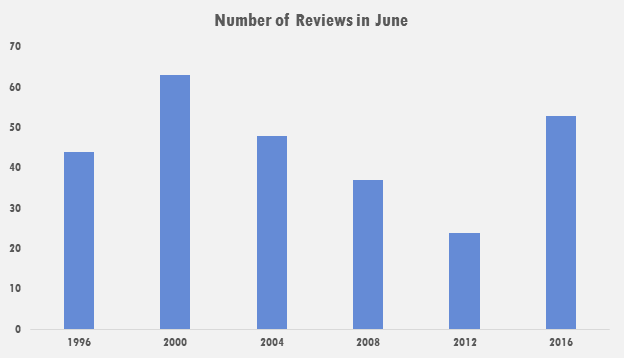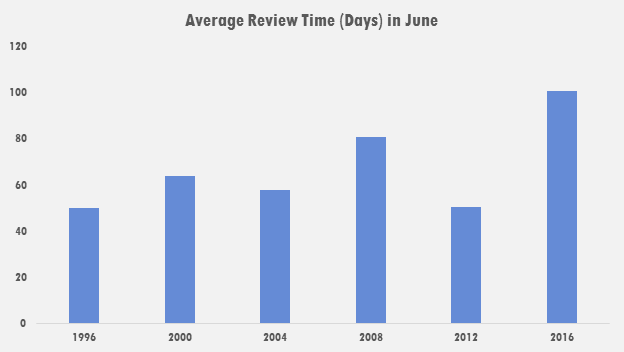Insight
July 7, 2016
Charting Midnight Regulation Before Dawn: June
In our series tracking regulation in the final year of the Obama Administration, this month once again proved the administration is on a record pace to issue significant regulation. Although the overall number of regulations reviewed increased from earlier months, the administration is approving a historic number of economically significant rulemakings (impact of $100 million or more). In March, the White House approved ten economically significant rulemakings, down from 15 in February. In April, that figure rose to 16 and in June the administration approved 17 significant rulemakings, more than any comparable period in the past 20 years.
Through the first six months of this year, regulators have approved 76 significant rulemakings; the next two closest years were 2008 and 2012, when regulators approved just 53 and 44 significant rulemakings in the first half. In other words, the White House has approved 43 percent more significant regulatory action than any comparable period since 1996.
With less than a year for President Obama to regulate, this is his midnight year for regulation. Although it’s not the official midnight period yet (defined as the period after Election Day, but before the next president takes office), each month the American Action Forum (AAF) will highlight the final regulatory activity of the administration and compare it to similar times in the past. This monthly series will highlight all of the rules leaving the White House scheduled for official publication, all economically significant measures, the length of time for White House review, the number of rules rejected or withdrawn from the rulemaking process, and the monthly cost of federal regulatory activity.
June 2016
The aggregate regulatory output last month was the second most of any period since 1996, trailing only 2000. The Office of Information and Regulatory Affairs (OIRA), the branch of the White House in charge of reviewing cabinet-agency regulation, concluded review of 53 rules, down from 57 rules in April. In June 2000, OIRA reviewed 63 rulemakings. The low point for June activity took place in 2012 when OIRA reviewed just 24 rules. The chart below tracks overall regulatory activity during these midnight years.
However, for economically significant measures, June of 2016 blew away the field. OIRA concluded review of 17 significant measures; this compares to just two significant rules in 2012, nine in 2008, and nine in 1996. Below are just some of the notable regulations released last month:
- National School Lunch Breakfast Program;
- Final Drone Rules;
- Borrower Defense Student Loan Standards; and
- Unified State Plans.
Despite the output of 17 significant measures, there are still 29 economically significant measures pending review (as of this writing), down from 32 measures last month, so agencies continue to add notable rulemakings at the White House. In June, OIRA received 44 additional measures (including 11 significant rules).
Once again, OIRA concluded review of several rules that had been under review for more than 120 days, which is the generally allowed timeframe for White House review under current executive orders. OIRA discharged seven rulemakings that had been under review for more than 120 days, including “Participation by Religious Organizations in USAID Programs,” which had been under review for 1,732 days, since 2011
In a continuing trend, June eclipsed all other similar periods during presidential election years for average review times. The average review time this month was 101 days, compared to 64 in June of 2000. However, the outlier review time of 1,732 days, mentioned above, severely skewed the data. The median review time in June 2016 was a more pedestrian 55 days.
For comparison, the chart below tracks the average review time since 1996 during midnight years.
With regard to “withdrawn” rulemakings, or measures that agencies and OIRA pull back from review, there were none in June. In contrast, there were three withdrawn measures in 2008, five in 2004, and five in 2000. There is an obvious disincentive for agencies to withdraw rules this late during an administration and the White House has not aggressively pulled back regulations from review, at least compared to other similar periods.
The Cost
Thanks to AAF’s Reg Rodeo tool, the public can track regulatory costs and paperwork burdens over time, including data on major rules, Dodd-Frank, and the Affordable Care Act. In June 2016, regulators finalized $4.3 billion in costs, down from $22 billion in May, and $33 billion in April. How does this compare to other similar periods? Although not a presidential election year, in June 2015, regulators published $17.6 in costs. In terms of paperwork, regulators published 4.2 million final hours this June, compared to June 2015, with 12.9 million hours.
Finally, there is the ultimate question of President Obama’s regulatory legacy. Through this point in his presidency (June of 2008), President George W. Bush had issued 423 major rules. By contrast, President Obama has issued 594, or 40 percent more than his predecessor. AAF will continue to publish monthly updates of similar periods in history.












